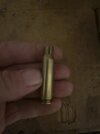Stevenvalleyky
Member
- Joined
- Jan 5, 2017
- Messages
- 276
Been handloading for more than 20 years, almost 40 if you count me pulling the handle with my grandpa at 4 or 5 years old. But I just bought my first AR15 and I know very little about them.
#1, should I expect to have to buy a small base FL sizing die or will the standard .223 dies I bought when they were on sale years ago generally be expected to work?
#2 I never use a cartridge checker and alway plunk test with my barrel. Is plunking a round in the barrel even possible with an AR or is the barrel extension in the way?
#3 I generally cut 1 case mouth vertically for every rifle caliber I load for so I can find the distance to the lands. (Im adding a pic of this so people understand what Im talking about with this one)
#4 What is generally the heaviest and longest bullet I can expect to shoot that will run through Pmags instead of having to single load? Several of the bullets I have looked at over 80 grains say they are too long to run through mags. Can the 75 and 77 grain bullets run through mags or do I have to go lighter? My gun is a 1/7 twist and seems to shoot the 69 gr factory rounds very well but I want to try as heavy as I can go while still feeding through mags.
Any help or advice would be appreciated.
#1, should I expect to have to buy a small base FL sizing die or will the standard .223 dies I bought when they were on sale years ago generally be expected to work?
#2 I never use a cartridge checker and alway plunk test with my barrel. Is plunking a round in the barrel even possible with an AR or is the barrel extension in the way?
#3 I generally cut 1 case mouth vertically for every rifle caliber I load for so I can find the distance to the lands. (Im adding a pic of this so people understand what Im talking about with this one)
#4 What is generally the heaviest and longest bullet I can expect to shoot that will run through Pmags instead of having to single load? Several of the bullets I have looked at over 80 grains say they are too long to run through mags. Can the 75 and 77 grain bullets run through mags or do I have to go lighter? My gun is a 1/7 twist and seems to shoot the 69 gr factory rounds very well but I want to try as heavy as I can go while still feeding through mags.
Any help or advice would be appreciated.



